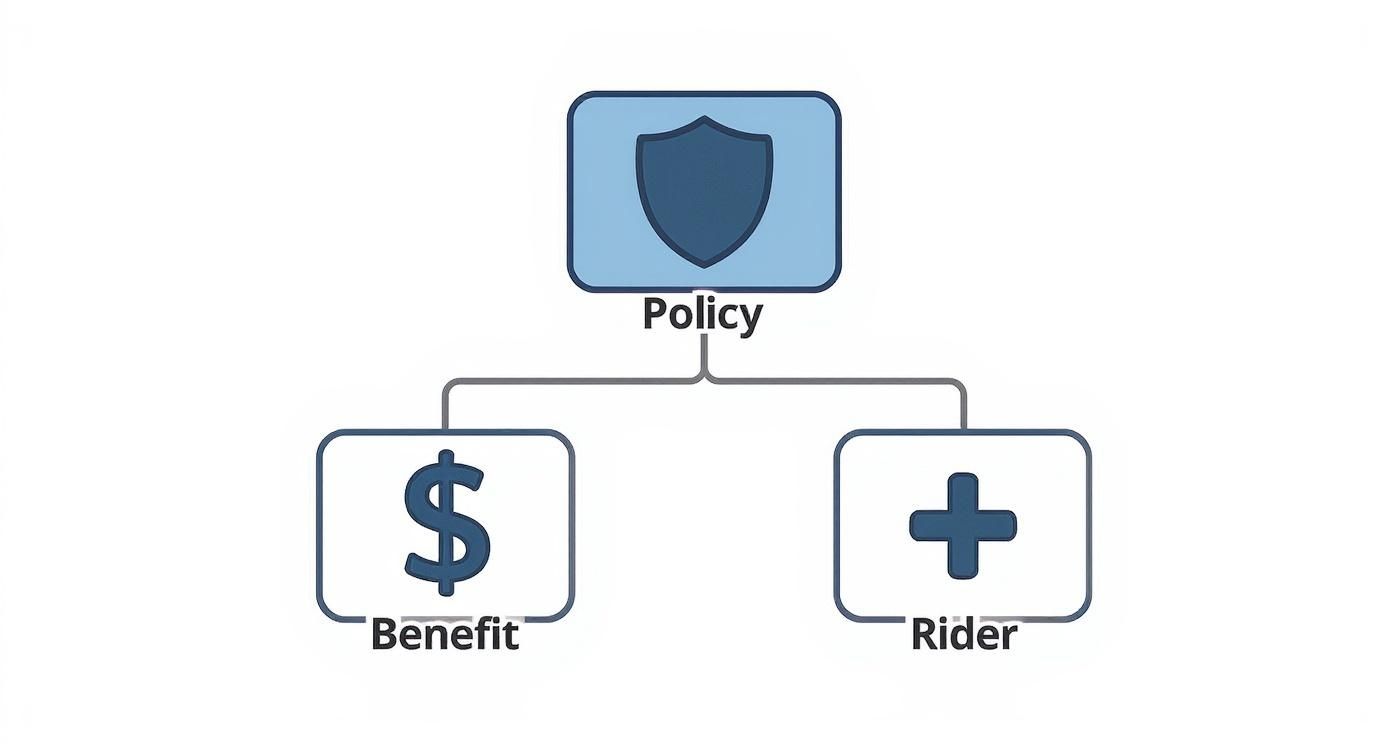Think of your life insurance policy as the foundation of a house—strong, reliable, and built to protect what matters most. But what if you need a little something extra, like a security system for added safety or a home office for your growing business?
That’s where riders come in.
A life insurance rider is an optional add-on that customizes your basic policy, giving you extra benefits for specific situations. It’s not a separate policy; it’s more like an upgrade that bolts directly onto your existing coverage, making it a perfect fit for your life.
So, What Is a Rider, Really?
Let's stick with the car analogy. Your standard life insurance policy is a brand-new car with all the essential safety features. A rider is like choosing an optional package—maybe you add all-wheel drive for snowy winters or a sunroof for those perfect sunny days.
Instead of buying a whole new car (or a separate insurance policy) for a specific need like long-term disability or critical illness, a rider lets you add that protection right to your main plan. It’s a way to tailor your coverage for the twists and turns life might throw at you, beyond just the death benefit. Getting a handle on this is often easier once you know the best time to consider life insurance in the first place.
This kind of personalization is more important than ever. The global life insurance market has ballooned to roughly $3.1 trillion, and as it grew, riders became a go-to tool for people to shape their policies to fit their actual lives.
To make it even clearer, let's break down the core differences between a standard policy and a rider.
Core Policy vs Rider At a Glance
| Feature | Standard Life Insurance Policy | Life Insurance Rider |
|---|---|---|
| Purpose | Provides a core death benefit to beneficiaries. | Adds specific, extra protections or benefits. |
| Nature | Standalone contract; the main coverage. | Add-on feature; attached to the main policy. |
| Cost | The primary premium for the policy. | An additional, usually smaller, cost. |
| Function | Pays out upon the insured's death. | Can pay out for events like illness or disability. |
Essentially, the policy is the "what," and the rider is the "what if."
A rider transforms a one-size-fits-all life insurance policy into a personalized financial tool. It’s the key to making sure your coverage adapts to your life, not the other way around.
Ultimately, a rider gives you a much more complete financial safety net. It’s a smart way to beef up your core protection, ensuring you and your family are truly prepared for whatever comes next. Before you start adding extras, though, it helps to have a solid grasp on the basics. For a deeper look, check out our guide on understanding life insurance policies.
Exploring the Most Common Life Insurance Riders
Think of your life insurance policy as the foundation of a house—strong, essential, and built to protect what matters most. But what if you could add a storm shelter, a security system, or even a guest house? That’s exactly what riders do.
They aren't one-size-fits-all; they’re custom additions designed for your specific life. A rider lets you fine-tune your coverage, turning a standard policy into something that truly fits your family.
This simple diagram shows how a rider snaps onto your main policy, expanding its protective power.

As you can see, it's all about enhancing the core benefit. Let's look at some of the most popular options people choose.
To make it easier, here's a quick cheat sheet summarizing the most common riders.
Quick Guide to Popular Life Insurance Riders
| Rider Name | Primary Purpose | Best For… |
|---|---|---|
| Accelerated Death Benefit | Access a portion of your death benefit early if you're diagnosed with a terminal illness. | Anyone wanting a financial cushion to cover end-of-life medical bills and expenses. |
| Waiver of Premium | Pauses your premium payments if you become totally disabled and can't work. | Individuals whose families rely on their income, especially those in physically demanding jobs. |
| Critical Illness | Provides a lump-sum payment if you're diagnosed with a major illness like cancer or a heart attack. | People who want funds to cover recovery costs, lost income, and out-of-pocket medical bills. |
| Child Term Rider | Adds a small amount of term life insurance for all of your children. | Parents looking for an affordable way to cover potential final expenses for their kids. |
| Spouse Term Rider | Adds term life insurance for your spouse to your existing policy. | Couples who want the convenience of managing one policy instead of two separate ones. |
Each rider serves a unique purpose, allowing you to build a policy that reflects your real-life needs and worries.
Riders That Protect You
Some of the most powerful riders are built to give you financial support while you’re still living. They’re often called “living benefits” because they act as a safety net for you, the policyholder.
- Accelerated Death Benefit (ADB) Rider: This is one of the most common add-ons, and many companies include it for free. If you're diagnosed with a terminal illness, it lets you access a chunk of your death benefit ahead of time.
- Waiver of Premium Rider: What happens if you become totally disabled and can't work? This rider steps in and pays your life insurance premiums for you, so your coverage stays active even when your income stops.
- Critical Illness Rider: If you have a heart attack, stroke, or get a cancer diagnosis, this rider pays you a lump-sum cash benefit. You can use that money for anything—medical bills, mortgage payments, or just giving yourself room to recover without financial stress.
Riders That Protect Your Family
Other riders are all about wrapping a bigger financial shield around your loved ones. They extend your policy’s protection to cover the people who depend on you most.
- Child Term Rider: For a small cost, you can add a single rider that provides a modest amount of term life insurance for all your children. It’s an affordable way to prepare for the unthinkable.
- Spouse Term Rider: Much like the child rider, this lets you add term life coverage for your spouse directly onto your policy. It’s convenient, but it’s always smart to compare it with a separate policy. You can dive deeper into how it works in our guide on the spouse term rider.
The truth is, people are tired of cookie-cutter insurance plans. More and more, families are looking for flexible products that do more than just pay out when someone dies. They want a plan that adapts to their life—and this global trend is only growing.
So, What Are the Real Benefits of Customizing Your Policy?
Why even bother with riders? Think of it this way: adding a rider transforms a generic, off-the-shelf life insurance policy into something that fits your life perfectly. It’s like tailoring a suit. It’s a strategic move that adds a deeper, more adaptable layer of security built around your unique circumstances.

One of the biggest wins here is cost. Trying to buy a separate long-term care or disability policy can get expensive, fast. A rider often provides very similar protection for a fraction of the cost, making truly comprehensive coverage much more accessible.
This approach simply creates a more complete safety net. A standard policy might cover the ultimate "what if," but what about the smaller crises that can still completely derail your finances? Riders are designed to fill in those critical gaps.
Adapting to Your Life as It Unfolds
Life is anything but static, right? Big moments like getting married, welcoming a child, or buying a home can change your financial needs almost overnight. Riders give your policy the flexibility to adapt right alongside you.
Let’s imagine a young couple, Alex and Ben. They start out with a basic term life policy.
- When they have their first child, they add a child term rider for affordable, just-in-case protection.
- If Alex becomes disabled and can't work, their waiver of premium rider kicks in, making sure their life insurance policy doesn't lapse when they can least afford it. You can see exactly how a waiver of premium rider works in our detailed guide.
- Later on, if Ben is diagnosed with a serious illness, their critical illness rider provides a lump sum to help manage medical bills without draining their savings.
Without these riders, each one of those events would have created massive financial and emotional stress.
By strategically adding riders, Alex and Ben built a resilient financial plan that grew with their family. It offered them genuine peace of mind that went far beyond just a death benefit.
This kind of flexibility is the real heart of understanding what is a rider on life insurance. It allows your coverage to be a living, breathing document that changes with you. It’s about more than just a payout after you’re gone; it's about providing financial support right when you need it most, tackling specific risks as they appear on your journey.
That proactive planning is the key to true financial security.
How to Add a Rider to Your Policy
Adding a rider to your life insurance policy is usually pretty straightforward, but timing is everything. The best time—and by far the most common—is when you first buy your policy. That’s when you’ll have the most options and can get everything bundled together right from the start.

While some insurers might let you add certain riders down the road, your choices will likely be limited. It’s always smarter to plan ahead and build the policy you actually need from day one.
The Steps to Adding a Rider
Adding a rider isn’t complex, but it does demand a little thought to make sure it truly fits your financial goals. Following a clear process helps you feel confident in your decision.
Here’s a simple breakdown of how it works:
- Assess Your Needs: First, take an honest look at your family’s situation. Do you have young kids? A mortgage to protect? A family history of a specific illness? Answering these questions will point you toward the protections that really matter.
- Consult an Advisor: Chat with a trusted insurance professional about your options. A good advisor can break down the details of each rider, explain the cost vs. benefit, and suggest riders that fit both your budget and your current stage of life.
- Undergo Underwriting: Just like with your main policy, adding a rider often means going through underwriting. The insurer will assess your risk to confirm you're eligible and determine the final cost. To get a full picture of what this involves, you can learn more about the life insurance underwriting process here.
- Review the Fine Print: Once you're approved, read the policy documents carefully. Check the rider's terms, conditions, and any exclusions. You need to be crystal clear on how it works and what it costs before you sign on the dotted line.
By thinking through your needs upfront, you can build a policy that offers more than just a death benefit. It becomes a dynamic financial tool ready to support your family through life's biggest challenges.
Key Questions to Ask Before Choosing a Rider
Picking a rider for your life insurance policy isn’t like choosing a topping for a pizza; it’s a real financial decision that needs to fit your actual life. Before you sign on the dotted line for any add-ons, it’s smart to take a step back and make sure you’re making a logical choice, not just an emotional one.
The first thing you’ll notice is the cost. While riders can add a powerful layer of protection, they also nudge your premium higher. So the big question is simple: is the peace of mind you’re buying worth the price? A rider should solve a real financial risk you might face, not just cover a far-fetched "what-if" scenario.
Beyond the cost, you have to dig into the rider's terms and conditions—the fine print. Look closely for any limitations, waiting periods, or exclusions that could stop a payout right when you need it most. For instance, a critical illness rider might only cover a very specific list of diagnoses, and you need to know what they are.
Are You Buying What You Actually Need?
The goal here is to get the right amount of coverage, not to be over-insured. It’s easy to get tempted by all the options available, but the key is to focus on riders that address the risks your family might genuinely face.
To help you decide, here’s a quick checklist of questions to run through:
- Is this a risk my family realistically faces? Think about your health, your job, and your family's medical history.
- Do I already have this coverage somewhere else? Check your health insurance or any disability plans from your employer to avoid paying twice for the same protection.
- Could my emergency savings handle this instead? For smaller financial bumps in the road, a rider might be overkill.
- What are the exact rules for a payout? Make sure you understand exactly what has to happen for the rider to kick in.
When you’re thinking about a rider, it’s also a good time to ask bigger questions about your policy’s role in your financial life. For example, it’s wise to understand how life insurance policies are treated in property division during major life events like a divorce.
A rider's true value isn't just in the protection it offers, but in how relevant it is to your life. The right rider delivers targeted security; the wrong one is just an extra bill to pay.
By taking a moment to think strategically, you can customize your policy with riders that give you genuine peace of mind and build a stronger financial safety net.
Common Questions About Life Insurance Riders
To wrap things up, let's tackle the questions that come up most often when people are figuring out if riders are right for them.
Are Riders Really Worth the Extra Cost?
This is the big one, and the honest answer is: it all depends on your life. A rider is worth every penny if it plugs a real financial hole your family could fall into.
Think about it. If your income is what keeps the mortgage paid and the lights on, a waiver of premium rider is a lifesaver if a disability stops you from working. But if you already have a solid emergency fund and great disability coverage through your job, you might skip it. The trick is to weigh the small extra premium against the massive financial headache the rider prevents.
Can I Add a Rider to a Policy I Already Have?
Usually, the best time to add riders is right at the beginning, when you first buy your policy. Some insurance companies will let you add certain riders later on, but your choices are often limited. Plus, you might have to go through another round of medical questions. It’s always smarter to think ahead and lock in the most important riders from day one.
Here’s a good way to think about it: It's way easier and cheaper to install a security system while your house is being built than to try and wire one in years after you've moved in.
How Many Riders Can I Add to a Policy?
There’s no universal magic number. It really varies from one insurance company to the next and depends on the specific policy you're looking at. Some insurers might have a cap on how many you can add or how much they can add to your premium.
But the goal isn't to collect riders like they're trading cards. The smart move is to pick a few that strategically cover your biggest worries. That way, you build a safety net that’s customized for you, without paying for protection you don't actually need.
At My Policy Quote, we believe insurance should be clear, simple, and built for you. If you’re ready to find a policy that fits your life—with or without riders—we’re here to help you get started.


